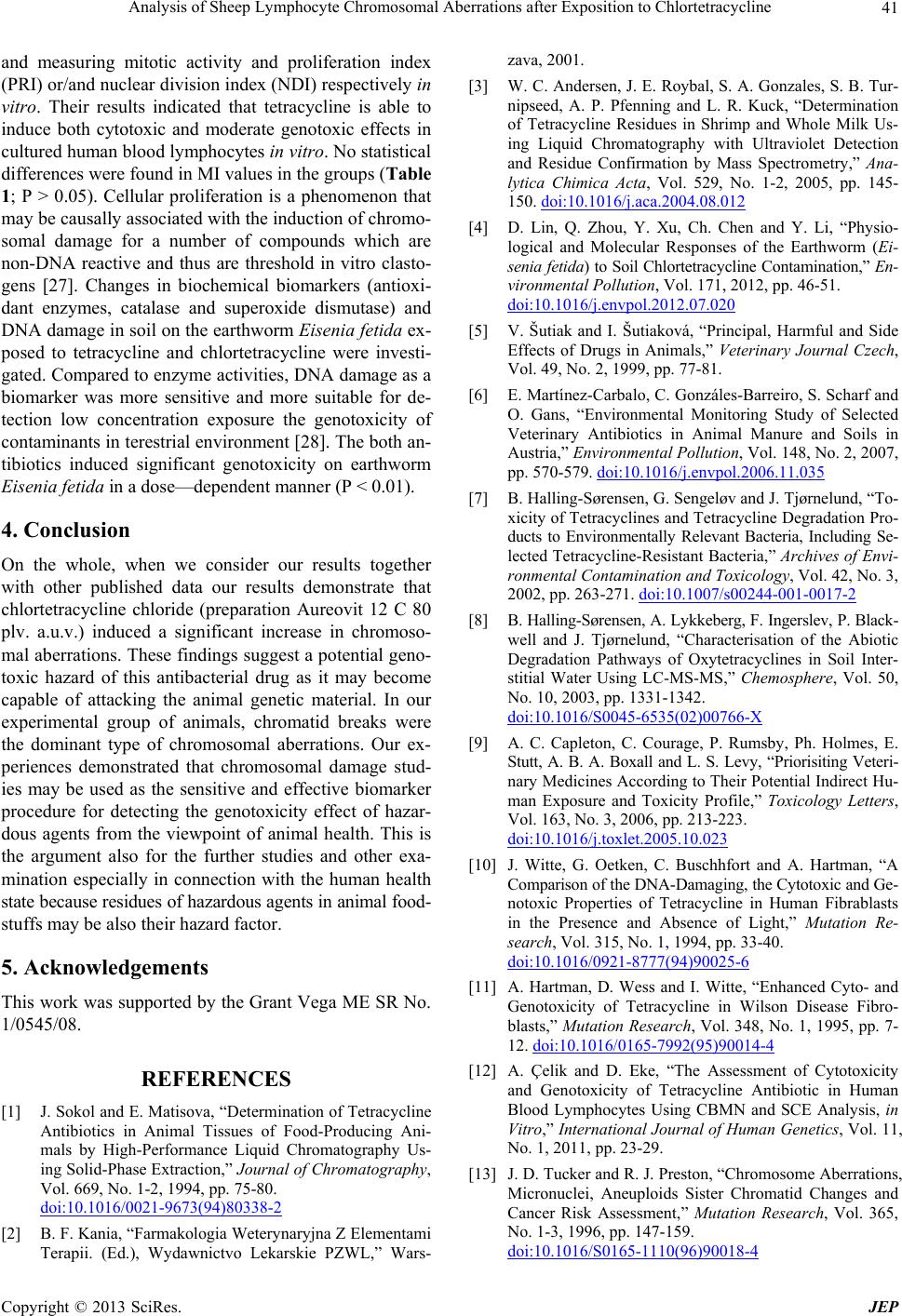
Analysis of Sheep Lymphocyte Chromosomal Aberrations after Exposition to Chlortetracycline 41
and measuring mitotic activity and proliferation index
(PRI) or/and nuclear division index (NDI) respectively in
vitro. Their results indicated that tetracycline is able to
induce both cytotoxic and moderate genotoxic effects in
cultured human blood lymphocytes in vitro. No statistical
differences were found in MI values in the groups (Table
1; P > 0.05). Cellular proliferation is a phenomenon that
may be causally associated with the induction of chromo-
somal damage for a number of compounds which are
non-DNA reactive and thus are threshold in vitro clasto-
gens [27]. Changes in biochemical biomarkers (antioxi-
dant enzymes, catalase and superoxide dismutase) and
DNA damage in soil on the earthworm Eisenia fetida ex-
posed to tetracycline and chlortetracycline were investi-
gated. Compared to enzyme activities, DNA damage as a
biomarker was more sensitive and more suitable for de-
tection low concentration exposure the genotoxicity of
contaminants in terestrial environment [28]. The both an-
tibiotics induced significant genotoxicity on earthworm
Eisenia fetida in a dose—dependent manner (P < 0.01).
4. Conclusion
On the whole, when we consider our results together
with other published data our results demonstrate that
chlortetracycline chloride (preparation Aureovit 12 C 80
plv. a.u.v.) induced a significant increase in chromoso-
mal aberrations. These findings suggest a potential geno-
toxic hazard of this antibacterial drug as it may become
capable of attacking the animal genetic material. In our
experimental group of animals, chromatid breaks were
the dominant type of chromosomal aberrations. Our ex-
periences demonstrated that chromosomal damage stud-
ies may be used as the sensitive and effective biomarker
procedure for detecting the genotoxicity effect of hazar-
dous agents from the viewpoint of animal health. This is
the argument also for the further studies and other exa-
mination especially in connection with the human health
state because residues of hazardous agents in animal food-
stuffs may be also their hazard factor.
5. Acknowledgements
This work was supported by the Grant Vega ME SR No.
1/0545/08.
REFERENCES
[1] J. Sokol and E. Matisova, “Determination of Tetracycline
Antibiotics in Animal Tissues of Food-Producing Ani-
mals by High-Performance Liquid Chromatography Us-
ing Solid-Phase Extraction,” Journal of Chromatography,
Vol. 669, No. 1-2, 1994, pp. 75-80.
doi:10.1016/0021-9673(94)80338-2
[2] B. F. Kania, “Farmakologia Weterynaryjna Z Elementami
Terapii. (Ed.), Wydawnictvo Lekarskie PZWL,” Wars-
zava, 2001.
[3] W. C. Andersen, J. E. Roybal, S. A. Gonzales, S. B. Tur-
nipseed, A. P. Pfenning and L. R. Kuck, “Determination
of Tetracycline Residues in Shrimp and Whole Milk Us-
ing Liquid Chromatography with Ultraviolet Detection
and Residue Confirmation by Mass Spectrometry,” Ana-
lytica Chimica Acta, Vol. 529, No. 1-2, 2005, pp. 145-
150. doi:10.1016/j.aca.2004.08.012
[4] D. Lin, Q. Zhou, Y. Xu, Ch. Chen and Y. Li, “Physio-
logical and Molecular Responses of the Earthworm (Ei-
senia fetida) to Soil Chlortetracycline Contamination,” En-
vironmental P ollution, Vol. 171, 2012, pp. 46-51.
doi:10.1016/j.envpol.2012.07.020
[5] V. Šutiak and I. Šutiaková, “Principal, Harmful and Side
Effects of Drugs in Animals,” Veterinary Journal Czech,
Vol. 49, No. 2, 1999, pp. 77-81.
[6] E. Martínez-Carbalo, C. Gonzáles-Barreiro, S. Scharf and
O. Gans, “Environmental Monitoring Study of Selected
Veterinary Antibiotics in Animal Manure and Soils in
Austria,” Environmental Pollution, Vol. 148, No. 2, 2007,
pp. 570-579. doi:10.1016/j.envpol.2006.11.035
[7] B. Halling-Sørensen, G. Sengeløv and J. Tjørnelund, “To-
xicity of Tetracyclines and Tetracycline Degradation Pro-
ducts to Environmentally Relevant Bacteria, Including Se-
lected Tetracycline-Resistant Bacteria,” Archives of Envi-
ronmental Contamination and Toxicology, Vol. 42, No. 3,
2002, pp. 263-271. doi:10.1007/s00244-001-0017-2
[8] B. Halling-Sørensen, A. Lykkeberg, F. Ingerslev, P. Black-
well and J. Tjørnelund, “Characterisation of the Abiotic
Degradation Pathways of Oxytetracyclines in Soil Inter-
stitial Water Using LC-MS-MS,” Chemosphere, Vol. 50,
No. 10, 2003, pp. 1331-1342.
doi:10.1016/S0045-6535(02)00766-X
[9] A. C. Capleton, C. Courage, P. Rumsby, Ph. Holmes, E.
Stutt, A. B. A. Boxall and L. S. Levy, “Priorisiting Veteri-
nary Medicines According to Their Potential Indirect Hu-
man Exposure and Toxicity Profile,” Toxicology Letters,
Vol. 163, No. 3, 2006, pp. 213-223.
doi:10.1016/j.toxlet.2005.10.023
[10] J. Witte, G. Oetken, C. Buschhfort and A. Hartman, “A
Comparison of the DNA-Damaging, the Cytotoxic and Ge-
notoxic Properties of Tetracycline in Human Fibrablasts
in the Presence and Absence of Light,” Mutation Re-
search, Vol. 315, No. 1, 1994, pp. 33-40.
doi:10.1016/0921-8777(94)90025-6
[11] A. Hartman, D. Wess and I. Witte, “Enhanced Cyto- and
Genotoxicity of Tetracycline in Wilson Disease Fibro-
blasts,” Mutation Research, Vol. 348, No. 1, 1995, pp. 7-
12. doi:10.1016/0165-7992(95)90014-4
[12] A. Çelik and D. Eke, “The Assessment of Cytotoxicity
and Genotoxicity of Tetracycline Antibiotic in Human
Blood Lymphocytes Using CBMN and SCE Analysis, in
Vitro,” International Journal of Human Genetics, Vol. 11,
No. 1, 2011, pp. 23-29.
[13] J. D. Tucker and R. J. Preston, “Chromosome Aberrations,
Micronuclei, Aneuploids Sister Chromatid Changes and
Cancer Risk Assessment,” Mutation Research, Vol. 365,
No. 1-3, 1996, pp. 147-159.
doi:10.1016/S0165-1110(96)90018-4
Copyright © 2013 SciRes. JEP